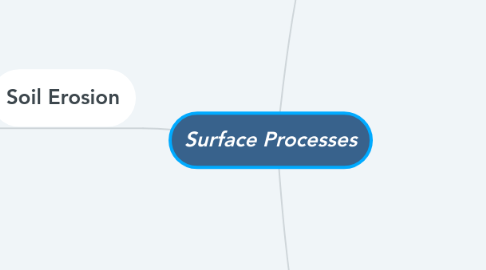
1. Soil Erosion
1.1. Causes
1.1.1. Kaingin Farming
1.1.2. Logging
1.1.3. Infrastructure Projects
1.1.4. Mining
1.1.5. Overgrazing
1.2. Methods on how to control
1.2.1. Rehabilitative method
1.2.1.1. Vegetative method
1.2.1.1.1. Cover cropping
1.2.1.1.2. Strip cropping
1.2.1.1.3. Contour tillage
1.2.1.1.4. Terracing
1.2.1.2. Mechanical method
1.2.1.2.1. Riprapping
1.2.1.2.2. Farm Ponds
1.2.2. Preventive method
1.3. Agents of erosion
1.3.1. Streams
1.3.1.1. Transportation
1.3.1.1.1. in solution
1.3.1.1.2. in suspension
1.3.1.1.3. scooting
1.3.1.2. Deposition
1.3.1.3. Floods
1.3.1.3.1. Shoreline Erosion
1.3.2. Glaciers
1.3.2.1. Types
1.3.2.1.1. Valley/Alpine Glaciers
1.3.2.1.2. Ice Sheets
1.3.2.1.3. Ice Caps
1.3.2.1.4. Piedmont Glaciers
1.3.2.1.5. Mountain Glaciers
1.3.2.1.6. Cirque Glaciers
1.3.2.1.7. Hanging Glaciers
1.3.2.1.8. Tidewater Glaciers
2. Weathering
2.1. Physical Weathering
2.1.1. Happens when rocks break up into tiny pieces without a change in their composition.
2.1.1.1. Frost Wedging
2.1.1.2. Pressure-release
2.1.1.3. Abrasion
2.1.1.4. Organic Activity
2.1.1.5. Thermal expansion and contraction
2.2. Mechanical Weathering
2.2.1. Happens when rocks break down into tiny pieces and change rock's composition or internal structure of minerals.
2.2.1.1. Dissolution
2.2.1.2. Hydrolysis
2.2.1.3. Oxidation
3. Mass Wasting
3.1. Factors that may trigger mass wasting
3.1.1. Water
3.1.2. Over steepened Slopes
3.1.3. Vegetation Removal
3.1.4. Earthquakes
3.2. Type of Material
3.2.1. debris, mud, earth
3.2.2. rock
3.3. Type of Motion
3.3.1. fall
3.3.2. slide
3.3.3. flow
3.4. Rate of Movement
3.4.1. fast movements
3.4.1.1. slump
3.4.1.2. rockslide
3.4.1.3. debris flow
3.4.1.4. earth flow
3.4.2. slow movements
3.4.2.1. creep
3.4.2.2. solifluction

